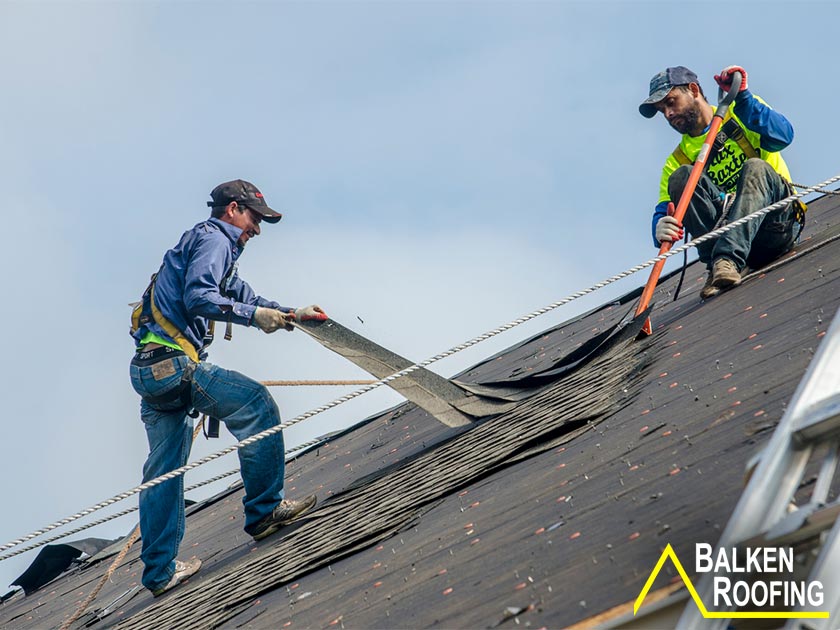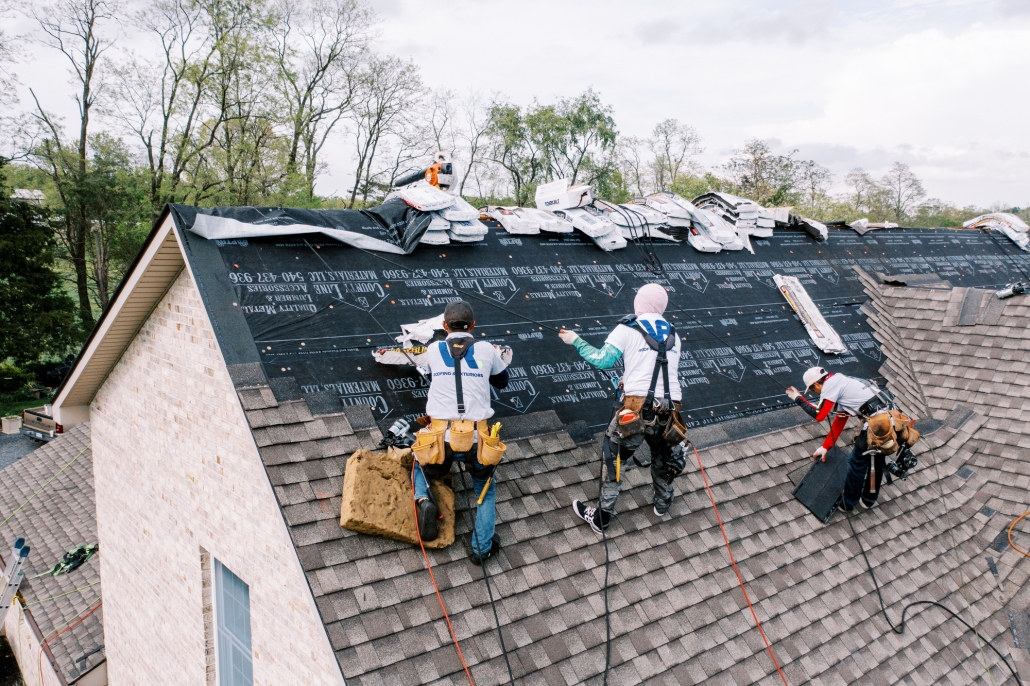The Ultimate Checklist for Roofing Install: Ensuring Quality and Sturdiness
The process of installing a roof requires mindful focus to information. A detailed checklist can aid guarantee quality and durability throughout the project. From reviewing the existing roofing condition to picking the best products, each step is important. Proper prep work and tools play an important function in accomplishing an effective installation. However, numerous forget the value of last assessments and recurring upkeep. Comprehending these elements can considerably affect the long life of a new roof covering.
Evaluating Your Present Roofing Condition
How can one properly figure out the condition of their existing roofing system? A thorough assessment is important for reviewing a roofing system's stability. House owners should start by taking a look at the roof from the ground, seeking visible indicators of wear such as missing roof shingles, drooping locations, or discoloration. Closer inspection can be done by accessing the roofing system itself, where one ought to check for cracked or crinkled tiles and evaluate blinking around vents and chimneys.Additionally, the interior of the home warrants interest; water stains or mold development on ceilings and wall surfaces may indicate leaks. Attic examinations can disclose possible concerns, such as poor ventilation or indicators of moisture.Regular evaluations, ideally twice a year, can assist determine troubles early and protect against pricey repair work. By recognizing the roofing's current state, property owners can make informed decisions around necessary upkeep or substitutes.
Picking the Right Roofing Products
When choosing roof covering products, what elements should homeowners take into consideration to assure a durable and effective selection? The environment plays a substantial duty; products ought to withstand neighborhood climate conditions, whether it's hefty rain, snow, or extreme sunlight. Next, the longevity of the product is necessary; alternatives like steel or slate offer prolonged life expectancies compared to asphalt tiles. Home owners must additionally examine the material's weight, as this can impact the structural integrity of the home. In addition, aesthetic appeals matter; the picked material needs to complement the total building style. Power effectiveness is another factor to consider; some products mirror warmth, reducing cooling expenses. Budget plan restraints will determine choices; while some products might have a lower upfront expense, lasting longevity can lead to better cost savings. By weighing these aspects, homeowners can make educated choices that improve their roof covering's high quality and longevity.
Planning for Installation
Before the setup procedure begins, property owners must guarantee that their property is sufficiently prepared to fit the new roofing system. This prep work includes several crucial steps to assure a smooth and reliable setup. First, home owners must get rid of the location around your home of any type of particles, tools, or furniture that could hinder access for professionals. Additionally, it is very important to notify next-door neighbors regarding the future job to decrease disturbance and safe and secure cooperation.Next, homeowners should inspect their existing roof and architectural parts, resolving any type of potential concerns such as rotting timber or leaks that could influence the installment. Securing necessary permits and sticking to neighborhood structure codes is crucial for conformity and safety and security. Ultimately, arranging the installation during desirable weather helps stop delays and guarantees that the job proceeds without complications. Correct preparation establishes the foundation for an effective roof covering project, eventually improving the long life and effectiveness of the brand-new roof.

Necessary Devices and Tools
In roof covering installation, having the right tools and devices is crucial for an effective job. This consists of necessary safety and security gear, various roofing installation devices, and reliable material dealing with equipment. Proper prep work and choice of these products can substantially improve effectiveness and safety on duty website.
Security Gear Necessities
Safety and security equipment is an essential part of any kind of roof covering setup project, ensuring the well-being of employees at raised heights. Important safety and security devices includes difficult hats, which shield versus falling particles, and security goggles to protect the eyes from dust and fragments. Non-slip shoes is considerable for maintaining grip on high surfaces, while harnesses and lanyards provide loss security, avoiding major injuries. Gloves aid secure hands from sharp materials and lower tiredness during prolonged durations of job. Furthermore, high-visibility vests improve visibility, promoting recognition among staff member and nearby employees. Making use of ear security might also be recommended in loud environments. In general, adhering to safety gear requirements is crucial for a risk-free and reliable roof website installment process.

Roof Covering Installment Tools
Proper precaution lay the foundation for a successful roof job, however having the right tools and tools is just as essential. Crucial devices for roof covering installment consist of a ladder, permitting secure accessibility to the roofing system, and a roofing nail gun to guarantee efficient and safe and secure attachment of products. A chalk line is crucial for noting straight lines, while an utility knife is necessary for reducing roof covering products precisely. Additionally, a lever help in eliminating old roof shingles. Employees must likewise have a level to validate appropriate alignment and water drainage. Ultimately, a good pair of job gloves safeguards hands while supplying grip. Together, these devices promote a smooth roof covering procedure, enhancing both top quality and resilience.
Product Handling Devices

A range of material handling devices is vital for an efficient roof installation process. Devices such as forklifts, hoists, and dollies promote the motion of hefty materials like tiles and underlayment to the work site and onto the roofing. Utilizing scaffolding and ladders guarantees secure access to elevated locations while minimizing the danger of injury. Tarps and containers are required for correct storage and company of materials, preventing damage and guaranteeing easy access. In addition, a crane may be needed for bigger roof covering jobs to lift substantial products straight onto the roofing system. Proper training in operation this tools is vital; it enhances workflow effectiveness and contributes to total task safety and security, guaranteeing a successful roof covering installation.
Step-by-Step Installation Process
The step-by-step setup procedure is essential for a successful roof installment. It starts with preparing the roofing surface, adhered to by the correct setup of underlayment, and ends with the effective securing of roofing materials. Each of these steps plays an important duty in guaranteeing the toughness and capability of the roof covering.
Prepare the Roofing Surface Area
Preparing the roofing surface is important for making sure an effective installment of roof materials. This process starts with a thorough inspection to recognize any kind of existing damages or particles. Any type of loose tiles, sticking out nails, or old roof materials must be gotten rid of to develop a clean, smooth foundation. Next off, the roof covering deck must be inspected for rot or structural concerns, as these can jeopardize the integrity of the brand-new roofing system. After repair services, a complete cleaning is necessary; this consists of sweeping away dirt, leaves, and any kind of other pollutants that could hinder adhesion. Lastly, guaranteeing proper drain and ventilation is crucial, as these elements affect the long life of the roofing system. A well-prepared surface establishes the stage for excellent installation and longevity.
Set Up Underlayment Effectively
Installing underlayment properly is basic for enhancing the total performance of the roof. The procedure begins with picking the suitable underlayment product, which can consist of felt, synthetic, or rubberized options. Next, validate the roofing system surface area is tidy and dry before laying the underlayment - roofing company honolulu. Begin at the cheapest point of the roofing system, turning out the underlayment horizontally and overlapping each row by at the very least 6 inches. It is essential to secure the underlayment in position with staples or roof nails, preventing voids or creases that might jeopardize water resistance. Trim excess material at the edges, assuring a neat finish. This meticulous installation step is vital for giving an added layer of protection against moisture and enhancing resilience
Protect Roof Materials Efficiently
After confirming the underlayment is correctly installed, the next step entails safeguarding the roof covering products successfully. The roof covering specialist must collect all needed materials, including tiles, nails, and blinking. Starting at the most affordable factor of the roofing, roof shingles should be stocked a staggered pattern, validating appropriate overlap to stop leakages. Each roof shingles should be fastened with nails, making use of the producer's suggested spacing and amount. It is vital to drive nails right, preventing over-penetration, which can compromise the material. Blinking must be installed around chimneys and vents to enhance waterproofing. The contractor ought to perform a detailed evaluation to validate all materials are safely attached, as this will significantly affect the roof's general durability and durability.
Carrying Out Last Inspections
Complete final inspections are necessary to guarantee that a recently set up roofing system fulfills all security and top quality standards. This crucial step involves reviewing the whole roof covering system for any potential issues that might arise post-installation. Assessors need to examine the placement of shingles, making sure they are correctly protected and without defects. Flashing and ventilation systems must also be evaluated for right installation and functionality.Additionally, the inspector should check gutters and downspouts to confirm they are appropriately placed to promote water drain. Any kind of indications of leakages, misaligned materials, or insufficient securing around infiltrations should be addressed promptly. Roofing contractors should likewise make certain that all particles from the installment procedure is gotten rid of, leaving the website clean and risk-free. Conducting these comprehensive evaluations helps protect against future difficulties, inevitably prolonging the lifespan of the roof and providing home owners with assurance regarding their financial investment.
Preserving Your New Roof
Appropriate upkeep is important for assuring the durability and efficiency of a new roof covering. Property owners need to conduct normal inspections at the very least twice a year, ideally in spring and autumn, to recognize potential problems early. Throughout these evaluations, they must look for indications of damages, such as missing roof shingles, leakages, or particles buildup, which can hamper water drainage and promote mold growth.Cleaning seamless gutters and downspouts is important, as stopped up systems can cause water damage and structural issues. Additionally, trimming overhanging branches can stop abrasion and particles buildup on the roof covering surface.It's likewise advisable to schedule professional evaluations every few years to examine the roofing's problem extensively. Maintaining documents of upkeep tasks and fixings can aid track the roof covering's efficiency with time (roofing contractors honolulu). By sticking to a constant maintenance routine, homeowners can secure their financial investment and guarantee their brand-new roof covering continues to be reliable for several years ahead
Regularly Asked Concerns
How Long Does a Typical Roof Covering Setup Take?
The duration of a regular roofing installment differs based on aspects such as roofing dimension, products, and weather condition conditions. Usually, it can take anywhere from one day to numerous weeks to finish the setup.
Can I Set Up a New Roof Covering Over an Existing One?
The inquiry of mounting a brand-new roofing system over an existing one commonly arises. Numerous homeowners consider this choice for cost-effectiveness, however it is vital to assess neighborhood structure codes and the structural stability of the existing roof covering.
What Permits Are Required for Roof Covering Installment?
Before installing a roofing, one have to check regional regulations. Typically, structure permits are needed, along with inspections to ensure conformity with safety requirements and zoning laws. Consulting with regional authorities is important for correct guidance.
What Service warranties Are Available for Roofing Products?
Numerous guarantees exist for roof covering materials, normally consisting of manufacturer guarantees covering issues and performance. In addition, some specialists supply workmanship guarantees, making sure installment top quality. Buyers should thoroughly examine terms to recognize coverage duration and limitations.
Exactly How Can Weather Condition Impact the Installment Refine?
Climate substantially impacts the installment procedure, as rainfall, snow, or severe temperature levels can postpone job, impact material bond, and compromise security. Proper planning and scheduling around weather projections are essential for successful roof installation.